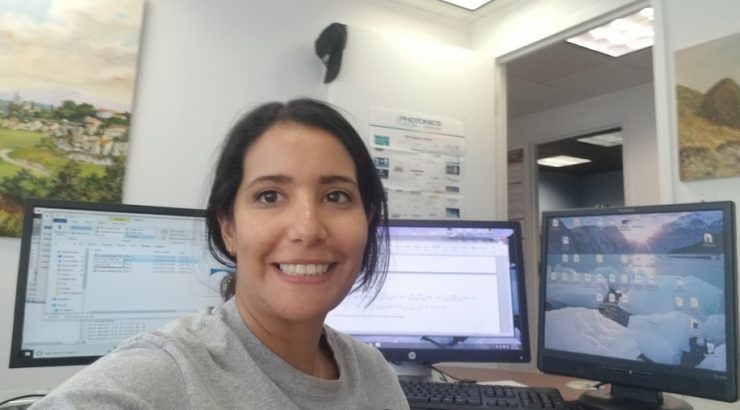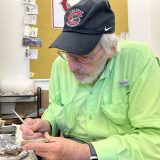
Seeking Truth Through Superconductivity CADS Ph.D. student, Iris Dorn, shares her experience writing a research paper with IQS faculty
September 23, 2019
Iris Dorn started as a Ph.D. student in the Computational and Data Sciences (CADS) Program in September 2018 under the supervision of Dr. Armen Gulian. Dr. Guilian is a member of the Insitute for Quantum Studies and is a Senior Research Scientist and Director of Chapman University’s Advanced Physics Laboratory, located in Burtonsville, Maryland. Dr. Gulian shares his research and guides Iris’ thesis work on modeling superconductivity in a software, Comsol Multiphysics, using the set of time-dependent Ginzburg-Landau equations that describes the state of superconductivity along a 1-dimensional wire.
This past summer, Iris spent a month in Dr. Guilan’s Advanced Physics Laboratory in Maryland writing a paper for the Physical Review B. Iris shared her summer experience and why she chose the CADS program to pursue her Ph.D.
Q&A with Iris:
Q: What did you learn from your summer experience?
ID: “My summer experience in Dr. Gulian’s lab taught me the process of writing grant proposals to help fund the lab as well as developing additional modeling skills. I also got to meet other scientists working in the lab, discuss their work and collaborate on ideas. He also had many visitors who discussed their current work as well. Writing the paper with Dr. Gulian was a very good learning experience because I was able to discuss directly with him his knowledge and quickly pick up the most important ideas. I am very grateful to Dr. Gulian for his many teachings.”
Q: What’s the Advanced Physics Laboratory research focus?
ID: “The mission is to search for room-temperature superconductors through experiments and modeling theory. Dr. Gulian has a team of researchers and post-docs who create potential superconducting films, measure, and test samples and explore the theory through finite element modeling.”
Q: Tell us about the paper you are writing for the Physical Review B?
ID: “Our paper is titled ‘Dynamics of Phase Slip Centers in 1D Wires of Finite Gap Superconductors at Phonon Feedback’. We are focused on modeling not just the 1d superconducting wire with a finite gap based on the set of time-dependent Ginzburg-Landau equations but to expand the model in complexity by including phonon terms, visualizing the set of current densities: normal, superconducting and interference, and most importantly, the phase slippage of the states of the wire, which occurs very rapidly around the range of picoseconds. Physical Review B is a peer-reviewed, scientific journal, published by the American Physical Society that focuses on condensed matter and materials physics. We plan to submit before the end of the year.”
Q: As a Ph.D. student working in a physics lab, what motivates you to push the boundaries of science?
ID: “Being able to play with the model on my computers and try new methods, hoping to discover something novel and maybe something much more interesting than novel, is my zen moment. Seeking truth in knowledge is very humbling and being fortunate to at least try is a blessing. I think we all want to discover something someday and I hope to do so too.”
Q: What led you to choose the CADS Ph.D. program at Chapman University?
ID: “My focus during my Master’s program at CSUF was on superconductivity and after obtaining my Master’s degree in 2016, I started working as an adjunct lecturer for the Physics department here at Chapman. I chose the CADS Ph.D. program because of the Institute of Quantum Studies and their excellent faculty and researchers who share the same interest in superconductivity as well as quantum foundation and quantum computing.”
Q: What advice do you have to offer undergraduate students who are looking to explore the field of computational and data science?
ID: “If you enjoy coding and mathematics, you should definitely learn about the program. You can have other focuses, such as physics or biology or psychology, that will be very complementary to your studies and you will end up with a very unique set of skills combined individually to your passions.”
Iris will be presenting her research in Boston at the Comsol Conference in October. If you would like to learn more about Iris’ research you can check out her website, or connect with her on Twitter or email.

